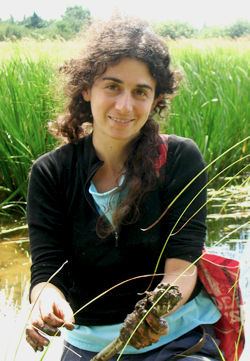Maine's indigenous plants help economy, Native Americans
By Alex Koeberle

Rocky shorelines teeming with lobster and dense pine and spruce forests often come to mind when thinking of Maine, yet the state is full of other natural resources of great value to those who live there.
Muskrat root, highbush cranberry, sweetgrass and goldthread: Michelle Baumflek knows them all well.
The Ph.D. student in the field of natural resources recently contributed to a U.S. Department of Agriculture report and online resource cataloging some of the 120 wild plant and fungus species gathered in the St. John River watershed of northern Maine. Baumflek found that nontimber forest products make substantial contributions to the economic viability and cultural vitality of the state. Maple syrup and conifer wreaths contribute more than $50 million to the northern forest economy annually, for example, while seasonal harvesting of species such as fiddlehead ferns often provide supplemental income for rural populations.
Baumflek works with two Native American tribes in northern Maine – the Houlton Band of Maliseets and Aroostook Band of Micmacs – who depend on local plants as part of their livelihoods. Her goal is to better understand how indigenous tribes steward plants that are important to them. This enthobotanical research encompasses traditional knowledge, plant use, health sovereignty and cultural identity.
“Native plant use is not just for health,” Baumflek said. “Plants are also important spiritually and are indicators of environmental health – they are all interconnected.”
Sweetgrass is used extensively as a smudge to purify and cleanse oneself before starting ceremonies, for example, while muskrat root is used to treat colds and flu. Highbush cranberry is loaded with vitamin C, can combat high blood pressure and is used as a powerful antispasmodic, Baumflek said.
These plants were valuable long before the 19th-century development that fueled Maine’s thriving paper, pulp and timber industry, and led to vast swaths of pine forests being clear-cut and overharvested. Forest covers two-thirds of the area where the Maliseets and Micmacs reside. The rest is dominated by agriculture, with commercial-scale potato, grain, hay and broccoli farming.
The indigenous tribes tend to plants in different ways, as part of a more holistic system, Baumflek said: “In the areas where I work, the land is used for different things than agriculture. People and their environment are deeply interconnected.
“These are active relationships,” she added. “We want to maintain this diversity.”
Her research involves community and botanic components. Baumflek works with locals to identify plants, run transects and take vegetation samples. She conducts group and individual interviews, attends ceremonies and organizes community meetings. This data is used to create habitat models for specific local plants as well as to understand how they are used.
Baumflek also collaborates with local tribes to transmit knowledge across generations by creating plant stewardship guidelines and high school curricula. “Elders within these communities don’t want this knowledge to die out,” she said.
Her research is also part of an international effort, headed by Karim-Aly Kassam, associate professor of natural resources, to connect indigenous communities around the world so they can find and share practical solutions to common problems.
Alex Koeberle ’13 is a writer for the College of Agriculture and Life Sciences.
Media Contact
Get Cornell news delivered right to your inbox.
Subscribe